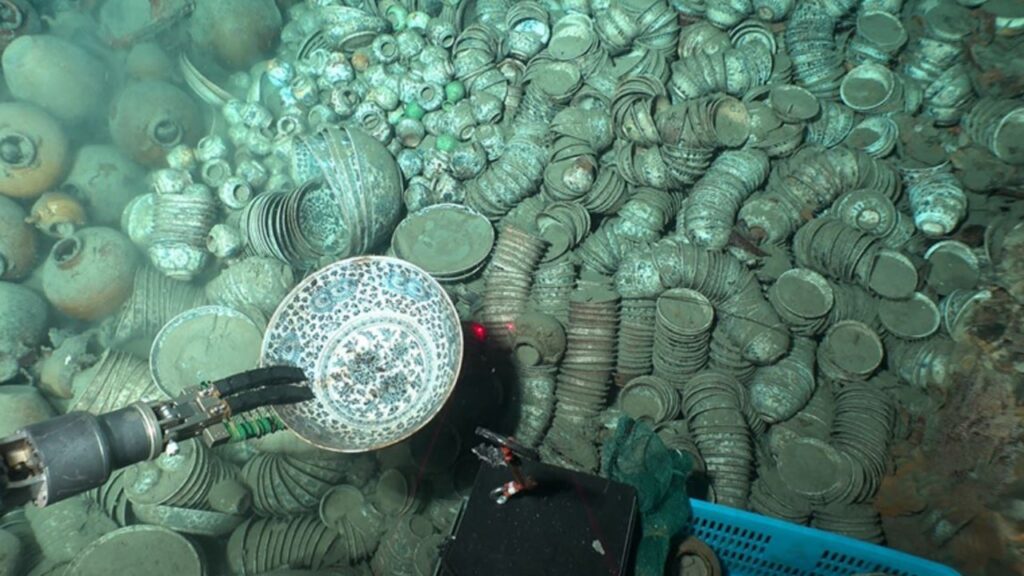Nearly 1,000 cultural relics have been recovered from shipwrecks dating back to the Ming Dynasty — from 1368-1644 — including porcelain and pottery, copper coins, and deer antlers, China’s National Cultural Heritage Administration (NCHA) said in a release Thursday. The underwater excavation of the shipwrecks began last year and shows that people from the Ming Dynasty used the South China Sea, known as the ancient Maritime Silk Road, as an important trade route, Guan Qiang, deputy head of the NCHA, said. The wrecks were first discovered in 2022, roughly 5,000 feet below the surface near the northwest continental slope of the South China Sea.
A total of 890 relics like coins, pottery and porcelain were found in the first shipwreck and 38, including pottery, porcelain, turban shells and lumber, were excavated from the second wreck. The excavators used the manned Deep Sea Warrior submersible to retrieve the items from the shipwrecks. The first ship appeared to mainly export porcelain while the second imported wood. The ships were found 10 nautical miles apart, according to FOX Weather.
“The well-preserved relics are of high historical, scientific and artistic value. It may be a world-class archaeological discovery in the deep sea,” Yan Yalin, China’s State Administration of Cultural Heritage archaeological director said after the ships were first discovered. A preliminary judgment of the cultural relics found in the water after the ships were discovered shows they are believed to be from the Zhengde period of the Ming Dynasty from 1506 to 1521. Numerous logs were also found, which were of similar size and neatly stacked, on the other ship. Some items on this ship possibly dated back to the reign of Emperor Hongzhi (1488-1505).
The agency said it was the first time ancient ships sailing and returning to the same sea area had been discovered in the country. The excavation of the shipwrecks is connected to China’s territorial claims on the South China Sea with its “nine-dash-line” policy, which has been disputed in international court. FOX Weather’s Chris Oberholtz contributed to this report.
This remarkable discovery sheds light on the significant role that the South China Sea played in facilitating trade and cultural exchange during the Ming Dynasty. The recovered artifacts provide valuable insights into the maritime activities of the time, showcasing the intricate network of trade routes that connected various regions in the region. The porcelain, pottery, and copper coins found in the shipwrecks not only speak to the economic prosperity of the era but also highlight the craftsmanship and artistic sophistication of Ming Dynasty artisans.
The presence of deer antlers among the artifacts suggests that these valuable commodities were also part of the trading activities conducted via the Maritime Silk Road. The meticulous excavation process conducted by the expert team using advanced technology underscores the importance of preserving and studying underwater cultural heritage. The discovery of ancient ships in the South China Sea further underscores the rich history and significance of this maritime region as a hub of commerce and cultural exchange.
As researchers continue to analyze the recovered relics and artifacts, more insights are expected to emerge regarding the specific trade routes and goods exchanged during the Ming Dynasty. The archaeological significance of these shipwrecks cannot be overstated, as they provide a rare glimpse into the material culture and economic activities of one of the most illustrious periods in Chinese history.
In conclusion, the recovery of nearly 1,000 cultural relics from Ming Dynasty shipwrecks in the South China Sea represents a significant milestone in underwater archaeology. The artifacts not only reflect the vibrant trade networks of the era but also highlight the cultural and historical significance of the region. As research efforts continue, these discoveries promise to deepen our understanding of the Ming Dynasty and its maritime connections, shedding new light on the intricate web of trade and cultural exchange that characterized this transformative period in Chinese history.












